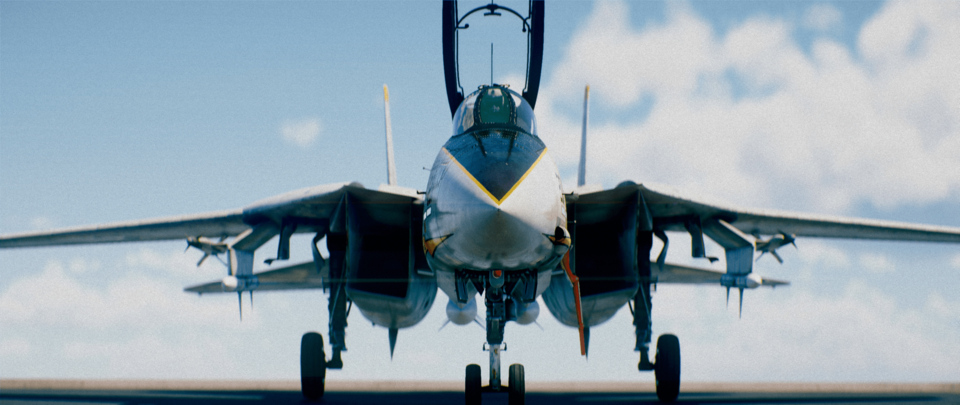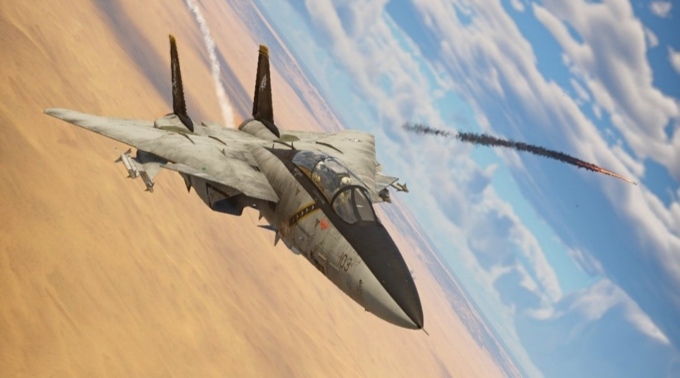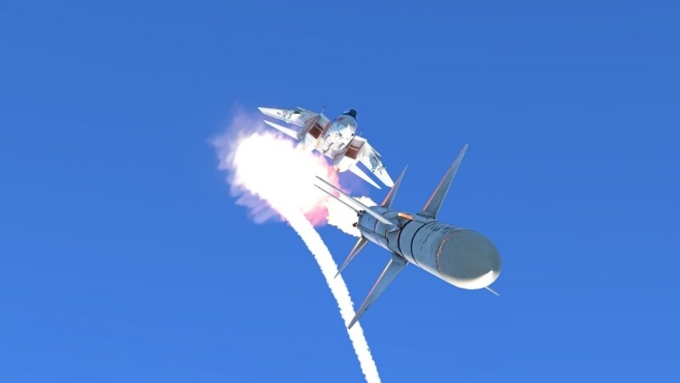Boasting a high-top speed, excellent turning characteristics, a large number of excellent missiles, and a powerful radar, the F-14A Early is a potent air superiority fighter and should be used as such.
Realistic Battles
In Realistic battles, the F-14A is a powerful air superiority fighter. With a maximum of six medium-range AIM-7F or very long-range AIM-54A missiles and a powerful radar, it is among the best BVR (Beyond Visual Range) fighters in the game, and it is advisable to exploit this advantage. In Air Realistic battles, players can side climb to high altitudes (>5 km) and search for targets to engage with the long-range Sparrows or Phoenixes. Once higher altitude is swept of enemy fighters, pilots can dive down on lower altitude enemies and use the energy advantage to obtain missile kills from an unexpected angle. If necessary, the Tomcat’s excellent maneuverability can be used to dogfight any remaining enemy aircraft.
In Ground Realistic battles, the F-14A can use its long-range missiles to clear the sky of enemy strike aircraft. With its excellent Sparrow and Phoenix missiles, the F-14A will be especially potent at destroying enemy strike aircraft at high altitudes who are using guided munitions to attack your team outside of SAM range. While the F-14A gets access to some air-to-ground bombs and rockets, these are all unguided and thus are very risky to use in the presence of SAMs. Therefore, unless a ground strike is absolutely necessary, a Tomcat is much better off in the air-to-air role guarding the skies.
Flying the F-14A
Despite being a very large aircraft, the F-14A Tomcat’s maneuverability and energy retention are excellent. With the wings swept out, it’s among the best rate fighters in the game, and has excellent instantaneous turn rate. This allows the F-14A to out-dogfight certain aircraft in-game.
For planes with poor energy retention such as F-4s, MiG-21s, J35s, and JA37s, you can use the F-14's excellent turn rate to enter a prolonged two-circle fight, where the F-14's superior energy retention will drain the energy of these delta-winged fighters. The optimal rate speed of the F-14A is around 750 km/h, though 600 km/h will still allow you to out-rate fighters with poor energy retention.
For planes with better energy retention such as F-8s and MiG-23s, you can use F-14A’s excellent instantaneous turn rate to force a one-circle fight. It should be noted that when dogfighting in the F-14A, it is critical to always sweep your wings forward to 0% wing sweep. At this wing sweep, you will obtain the optimal energy retention and turn characteristics of the F-14A. Therefore, it is highly recommended to set key binds for manually changing the sweep angle and switching between auto to manual wing sweep.
Keep in mind that, although the F-14A has excellent dogfighting characteristics, it is still a very large aircraft with extremely hot engines. Due to this, it is advised to avoid turn-fighting in the Tomcat unless absolutely necessary because, as with all other top-tier jets, doing so will bleed your speed and make you an easy target for enemy aircraft.
The early F-14A with its TF30 engines were historically underpowered, and this shows in-game: while the F-14A has a great top speed with the wings swept back, the acceleration and climb rate is below average. Faster planes such as MiG-23s, Mirage 2000s, F-16s, and MiG-29s will easily out-accelerate you. Even F-4s will accelerate faster at lower speeds. Therefore, it is advisable to keep your speed up in the F-14. Due to this, vertical dogfights are generally not advisable, especially with faster accelerating and climbing opponents such as MiG-23s, MiG-29s and F-16s. In addition, this acceleration is another reason to be careful when engaging in dogfights, as you will have difficulty out accelerating your opponents should you need to exit.
Wing Sweep
The F-14A has a variable sweep wing, which means the wings can change angle during flight to obtain the desired flight characteristics. As discussed before, when the wings are swept forward (0%), the F-14A obtains high energy retention and excellent instantaneous and sustained turn rate. However, the wings being swept forwards limits the Tomcat’s top speed, and therefore should only be used at lower speeds, when dogfighting, or take-off/landing (especially on carriers). On the other hand, the wings being swept back allows the F-14A to reach its top speed, but at lower speeds, the reduced lift and greater wing loading heavily reduces maneuverability. Generally, pilots can keep the wing sweep mode set to automatic (AUTO); this will automatically sweep the wings without player input based on how fast or slow the Tomcat is going. However, when dogfighting, you will want to switch the sweep mode to manual and use selected key binds to manually sweep the wing completely forward to obtain optimal maneuverability.
Fuel Consumption and Engine Heat
It should be noted that the F-14A burns through its fuel supply extremely fast when on full afterburner. This should be taken into consideration as one can use up all their fuel without realizing until it is too late. Due to this, it is advisable to take at the very least 30 minutes of fuel. You can use the mouse scroll wheel to save a lot more fuel by using the first-stage afterburner, which gives a significant power boost from 100% throttle but a little less power than full afterburner. On minimum fuel (18 minutes) the full afterburner can only last about 2 minutes and 30 seconds, but the afterburner (first-stage) can last you 8 minutes.
Something to be aware of when playing the F-14A is the insane heat of its engines. At high throttle and afterburner, its engines emit an unparalleled amount of heat at around 2,100 °F (1,150 °C). For reference, that is around 66% hotter than the F-4J’s engines, which are around 1,239 °F (671 °C) at 100% throttle and 1,256 °F (680 °C) during full afterburner. During gameplay, this means that in the F-14A simply just turning off the afterburner and deploying flares may not be enough to avoid an incoming IR missile. It is recommended to throttle down the engine significantly (at least 80-85%) to make sure that an incoming IR missile goes for the flares. This is especially true for more flare-resistant IR missiles such as the AIM-9L and AIM-9M, Magic 2, and R-73 which may need substantial throttling down to flare off. Keep in mind that throttling down means that you will lose a decent amount of speed in the process, so be prepared.
Radar and Radar Modes
The AN/AWG-9 radar set carried by the F-14A is an extremely potent radar, especially for long-range missile combat. It has great range (a maximum of 185 km tracking and 370 km detecting). For most normal air RB maps, a 37 km or 93 km display range should suffice, while 93 km should be enough for most Enduring Confrontation maps. A radar lock is necessary to guide Sparrows, while either radar lock or soft lock (selecting targets in TWS) will suffice for a Phoenix launch. The radar has four different modes which have different purposes, capabilities and usages:
- SRC PD HDN (Surveillance Radar Computer, Pulse-Doppler, Head-On): Users of the F-14 are likely at least somewhat aware of what a pulse-Doppler radar is from usage of the previous F-4J. This is a pulse-Doppler mode, meaning it measures an aircraft’s Doppler shift (difference in velocity compared to surroundings) in order to “see” targets. Due to the nature of the detection method, this pulse-Doppler mode is most ideal for targets close to the ground, as well as in head-on situations (as the name suggests). However, this pulse-Doppler mode has a weakness: it can be notched; pulse-Doppler measures the target aircraft’s velocity change compared to surroundings, so if a target flies perpendicular to the radar (not moving closer or further compared to the surroundings), the radar will not observe a change in velocity and therefore cannot see the aircraft. F-14A pilots must be aware of how the notch works; if an enemy radar is locking you at low altitude, they are likely using a pulse-Doppler mode, and thus notching becomes a defensive option to break radar lock. Provided the target is not at very low altitudes, an enemy notching your pulse-Doppler radar can be countered by switching the radar mode to SRC. Another weakness to be aware of is that pulse-Doppler modes generally have trouble detecting and locking targets travelling away from the radar. In conclusion, the pulse-Doppler mode is good for tracking targets at very low altitudes but is vulnerable to notching and has difficulty finding targets moving away.
- SRC (Surveillance Radar Computer): This is the standard radar mode. It is not a pulse-Doppler mode and does not have its weaknesses; it cannot be notched like pulse-Doppler can and has an easier time tracking targets moving away. Therefore, if an enemy is attempting to notch your pulse-Doppler mode, you can switch the radar lock from a pulse-Doppler one to standard SRC. However, due to the radar return from ground clutter, it has great trouble locking targets at very low altitude, though it can still lock higher targets. It’s worth noting that the SRC mode on the AN/AWG-9 is more resistant to ground clutter than previous radars; while you still cannot detect or lock a target very close to the ground, it can sometimes detect targets as little as 1 km from the ground. As such, SRC is generally more reliable at finding and tracking targets than pulse-Doppler mode but cannot see targets at very low altitudes like pulse-Doppler can.
- TWS HDN (Track While Scan, Head-On): This mode allows targets to be detected and “tracked” simultaneously. By hovering your radar cursor over detected targets, you can “soft lock” them; their position is marked in third-person view, and their general speed, heading, and height are displayed. With a soft lock, the radar return is not strong enough to trigger the RWR, so enemies will not know you are soft locking them. AIM-54A Phoenixes can be launched via a soft lock, and after launching a Phoenix, you can hover over another enemy to launch another Phoenix. Using onboard electronics, the Phoenixes will guide themselves to the target after this. In addition, AIM-9G/H Sidewinders can be slaved to the soft lock. However, for a Sparrow launch, you will need to “hard lock” the target. This can be done simply by locking the target the cursor is hovering over (as with other radar modes). In addition, track while scan uses pulse-Doppler, so it can detect targets close to the ground as well. Unfortunately, this also means it has the same weaknesses as pulse-Doppler mode (vulnerable to notching or targets flying away). The capabilities of the track while scan mode are potent and allows pilots great situational awareness, and therefore should generally be your go-to radar mode, only switching to SRC to overcome pulse-Doppler’s weaknesses.
- SRC PDV HDN (Surveillance Radar Computer, Pulse-Doppler Velocity, Head-On): This radar mode is very similar to pulse-Doppler, but instead displays the velocity of the aircraft on the radar screen rather than the range. This is the only radar mode on the AN/AWG-9 which does not utilize IFF (Identification Friend or Foe), so be careful in Simulator mode.
The AN/AWG-9 has two acquisition modes: ACM PD HDN and ACQ; and two track modes: TRK PD HDN and TRK SRC PD HDN.
- SRC PD HDN, TWS HDN and SRC PDV HDN radar modes all use ACM PD HDN (Air Combat Maneuvering, Pulse-Doppler, Head-On) as the acquisition mode, and TRK PD HDN (Track, Pulse-Doppler, Head-On) as the lock mode. These are pulse-Doppler search and lock methods, and as such have the same strengths and weaknesses. SRC uses ACQ and TRK as acquisition and lock modes, respectively, which are the non pulse-Doppler counterparts to ACM PD HDN and TRK PD HDN.
- When in these acquisition modes, you can press your keybind for “Change Radar/IRST Search Mode” to change the scope of the acquisition search area. Clicking it once changes it from a square to a vertically long rectangle, clicking it twice moves this rectangle to an upper position (to lock enemies above you), and clicking it a third time changes it back to a square.
- A nice and very useful feature of the F-14's radar is that, if you have a target radar locked, you can switch between pulse-Doppler and normal SRC tracking without breaking lock (most other radars will require the lock to be broken before switching radar mode to reattempt a lock). This allows you to quickly and easily switch to TRK (SRC) if the target is notching, or switch to TRK PD HDN (Pulse-Doppler) if the target is going close to the ground.



